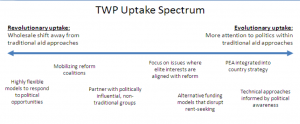Approaches to Working in Politically Informed Ways
The Executive Session on the Politics of Extractive Industries
November 2019
Actors working on supporting progress on the governance of extractive industries (GEI field) have long understood the importance of political context in determining outcomes from EI and from interventions designed to improve these. Much less clear has been how to systematically integrate political concerns – related to power, interests/incentives and political systems – into this work. While important progress has been made on normative and technocratic approaches to improving GEI, to date, the tools and approaches for addressing issues related to political context within the GEI field have been more limited and often ad hoc; better approaches are urgently needed. This is not just a challenge for the GEI field but for those working on governance in the broader development community. As the Executive Session (ES) grapples with the challenge of how to better integrate political considerations into practice in the GEI field, we have come across valuable resources on working politically from this broader community. We are sharing a sampling of these here in order to catalyze and inspire others who might be trying to get a better handle on how to work in more politically informed ways in practice.
ES’ overarching framing for engaging with political realities.
The ES considers three overarching orientations to addressing political challenges to good governance of EI:
- navigating existing political realities as they actually are;¹
- focusing effort on changing the source of the challenges in question (e.g., re: balance of power or nature of interests/incentives); or
- trying to avoid political roadblocks by generating strategies to circumvent themand potentially the actors responsible.
A range of options from evolutionary to revolutionary:
When it comes to conveying a range of options for working politically, this oft-cited table emerging from early discussions within the Thinking and Working Politically community of practice (TWP) provides an illustrative overview of different ways a political lens might be integrated into efforts by donors to improve development outcomes.² Beyond the donor community, the ES thinks that TWP’s (non-exhaustive) list of political approaches can inspire specific ideas for changing practice across a range of actors and issue areas:

Each of these, explained in more detail below, is the kernel of an approach to addressing different challenges and opportunities arising from issues of power, interests, political decision-making processes, and political systematic attributes, listed right to left, from those that can be layered onto existing work to those that require a fundamental departure from current practice. Depending on the user, their own institutional preferences and power, and nature of the issues being confronted, different options will resonate.
- Technical approaches informed by political awareness – the use of knowledge of political context – interests, institutions and incentives of a range of key actors for a given issue area – to guide the design/deployment of existing technical approaches.
- PEA integrated into country strategy – to the extent to which an organization undertakes country-specific work, it could include some sort of political economy analysis (PEA) as an input into the design of strategies and programming.
- Alternative funding models that disrupt rent-seeking – having flexible ‘managed funds’ that sit with the local team and can be deployed for specific initiatives as you go along, rather than pre-set amounts of finance for set purposes laid out in advance as is common in usual project planning.
- Focus on issues where elite interests are already aligned with reform – rather than external actors advocating for reforms (even if based on “best practices”) that key political and economic elites are likely to oppose or implement weakly, seek to identify those areas that might improve development outcomes or governance of EI on terms these elites already have an interest in supporting.
- Partner with politically influential, non-traditional groups – looking outside the realm of formal policy-makers for other actors with the power and incentives to help bring about particular desired outcomes in a given issue area.
- Mobilizing reform coalitions – when the power of those supporting reforms needs to be bolstered in order to achieve impact, figuring out which actors could contribute to a particular outcome being successful and connect actors whose interests align with reform agenda.³
- Approaches that prioritize responsiveness to political opportunities/fundamentally driven by political context – very bottom-up, localized and flexible approach that focuses on opportunistically identifying and exploiting opportunities for making progress toward a particular, context specific objective. This is in direct contrast with global models and generic notions of best practice. Ideas for working on GEI based on this orientation would start by working with local actors to identify what they see as problems or goals related to outcomes from EI and then try to reverse engineer strategies to try to address these based on openings and resources available, including facilitation of local actors to drive the problem-solving process.
On producing and using PEAs. There are numerous resources for those wishing to undertake PEAs to map the political landscape as an input into any of the above TWP approaches. Many are captured in this resource guide for practitioners. This report by the World Bank examines the use of a specific type of “problem-driven” PEA which narrows the scope of the analysis to a specific issue or problem rather than the broader political context. For a lighter-touch treatment that a range of organizations and actors might use to think through some basic issues around interests and incentives as they relate to their work and determine whether and how these might be addressed in different ways, see everyday political analysis. Finally, The Policy Practice published a piece a few years back which examines the evolving role of political economy analysis in development practice and contains practical recommendations for donors and their implementing partners.
Inverting traditional approaches to development and emphasizing learning.
Another line of thinking sometimes applied to attempts to work politically is an approach characterized as Problem Driven Iterative and Adaptive (PDIA). Though focused on broader context beyond just political content, PDIA could be applied more narrowly to political context and “is a step-by-step approach which helps you break down your problems into its root causes, identify entry points, search for possible solutions, take action, reflect upon what you have learned, adapt and then act again. It is a dynamic process with tight feedback loops that allows you to build your own solution to your problem that fits your local
context.” For example, the Facility for Oil Sector Transparency and Reform (FOSTER) in Nigeria employed a local team that constantly explored the political horizon and attempted to build reform coalitions of relevant actors on issues as it went along. Other examples are explored in “Politically Smart, Locally Led Development”, which highlights some common characteristics of successful politically informed programs: politically savvy, locally-led, take an iterative and adaptive approach to programming (enabled by flexible and strategic funding), broker relationships with key interest groups, and have continuity of staff and funding commitment.
Approaches to working in difficult places.
This recent blog post summarizes research on empowerment and accountability strategies developed in stable states and applies them in fragile or violent states. Alongside each of five main findings, the analysis offers specific thoughts on practical implications. The Anti-Corruption Evidence research consortium at SOAS (SOAS ACE) looks at countries where traditional anti-corruption approaches based on transparency and the rule of law have proven ineffective because of strong competing incentives and seeks feasible and effective alternatives. They look for creative strategies based on analyses of key actors and their interests and how these can be best leveraged to reduce corruption in a particular context, including around the oil sector in the Niger Delta.
Recent examples of working politically in practice.
A few examples of working in politically informed ways have caught our eye over the last few months:
- A seemingly effective strategy for dealing with conflicts of interest undermining the integrity of environmental audits in Gujarat, India.
- Accountability Lab’s Citizen Helpdesks (CHD) in mining communities in Liberia, a standing platform designed to augment community power in interactions with mining companies by collecting and sharing information to initiate feedback loops among citizens, the mining companies and local power-holders.
- Nepal’s Economic Policy Incubator illustrates a PDIA approach in action and suggests some early lessons about the value of this approach.
- The development entrepreneurs approach to promoting various reforms in the Philippines.
- Finally, for more general reflections on where TWP approaches have gotten to and where they should be going, see TWP: Reviewing the evidence on integration of politics into development practice over the last decade and Thinking and Working Politically: From Theory Building to Building an Evidence Base.
1 This orientation is typified by Levy’s “working with the grain” approach https://workingwiththegrain.com/
3 The Anti-Corruption Evidence (ACE-SOAS) strategy of building coalitions to bring pressure for effective implementation is an example of this.

